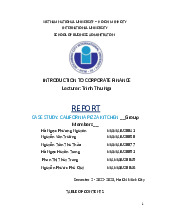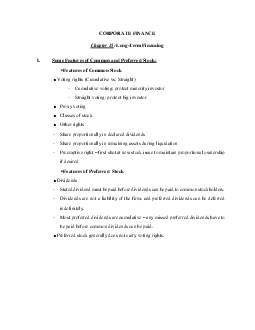









Preview text:
lOMoARcPSD|364 906 32 Question #1 of 33 Question ID: 1379921
Which of the following factors is least likely to affect an investor's risk tolerance?
A) Number of dependent family members.
B) Level of insurance coverage.
C) Level of in ation in the economy. Question #2 of 33 Question ID: 1379944
Which of the following statements is most accurate about integrating ESG considerations into portfolio planning and construction?
Investors who engage in active ownership to pursue their ESG considerations
A) should vote their shares themselves rather than delegating
share voting to an investment manager.
Integrating ESG considerations into portfolio planning and construction is likely to
B) decrease portfolio returns.
A broad market index is an inappropriate benchmark for a portfolio that uses C)
negative screening to address the investor’s ESG concerns. Question #3 of 33 Question ID: 1379937
When developing the strategic asset allocation in an IPS, the correlations of returns:
A) among asset classes should be relatively high. B) within
an asset class should be relatively high.
C) within an asset class should be relatively low. Question #4 of 33 Question ID: 1379918
Which of the following statements about the importance of risk and return in the investment objective is least accurate? lOMoARcPSD|364 906 32
Expressing investment goals in terms of risk is more appropriate than expressing A) goals in terms of return.
The return objective may be stated in dollar amounts even if the risk objective is B) stated in percentages.
The investor’s risk tolerance is likely to determine what level of return will be C) feasible. Question #5 of 33 Question ID: 1379938
When performing strategic asset allocation, properly defined and specified asset classes should:
A) approximate the investor’s total investable universe as a group.
B) each contain assets that have a broad range of risk and expected return.
C) have high returns correlations with other asset classes. Question #6 of 33 Question ID: 1379935
When preparing a strategic asset allocation, how should asset classes be defined with respect to the
correlations of returns among the securities in each asset class?
A) Low correlation within asset classes and high correlation between asset classes.
B) High correlation within asset classes and low correlation between asset classes.
C) Low correlation within asset classes and low correlation between asset classes. Question #7 of 33 Question ID: 1379941
A portfolio manager who believes equity securities are overvalued in the short term reduces the weight
of equities in her portfolio to 35% from its longer-term target weight of 40%. This decision is best described as an example of: A) rebalancing.
B) strategic asset allocation. lOMoARcPSD|364 906 32
C) tactical asset allocation. Question #8 of 33 Question ID: 1379936
Which of the following asset class specifications is most appropriate for asset allocation purposes? A) Domestic bonds. B) Emerging markets.
C) Consumer discretionary. Question #9 of 33 Question ID: 1379940
An investment manager has constructed an efficient frontier based on a client's investable asset classes.
The strategic asset allocation for the client should be the asset allocation of one of these efficient
portfolios, selected based on:
A) the client’s investment objectives and constraints.
B) a risk budgeting process.
C) the relative valuations of the investable asset classes. Question #10 of 33 Question ID: 1379913
Which of the following is NOT a rationale for the importance of the policy statement in investing? It:
A) forces investors to understand their needs and constraints.
B) helps investors understand the risks and costs of investing.
C) identi es speci c stocks the investor may wish to purchase. Question #11 of 33 Question ID: 1379932
An endowment is required by statute to pay out a minimum percentage of its asset value each period to
its beneficiaries. This investment constraint is best classified as:
A) legal and regulatory. lOMoARcPSD|364 906 32 B) liquidity.
C) unique circumstances. Question #12 of 33 Question ID: 1379914
Which of the following is not necessarily included in an investment policy statement?
A) Procedures to update the IPS when circumstances change.
B) A benchmark against which to judge performance.
C) An investment strategy based on the investor’s objectives and constraints. Question #13 of 33 Question ID: 1379920
A return objective is said to be relative if the objective is:
A) stated in terms of probability.
B) compared to a speci c numerical outcome.
C) based on a benchmark index or portfolio. Question #14 of 33 Question ID: 1379928
Which of the following should least likely be included as a constraint in an investment policy statement (IPS)?
A) How funds are spent after being withdrawn from the portfolio.
B) Any unique needs or preferences an investor may have. lOMoARcPSD|364 906 32
C) Constraints put on investment activities by regulatory agencies. Question #15 of 33 Question ID: 1379929
Categories of investment constraints in an investment policy statement least likely include: A) tax concerns. B) liquidity needs. C) risk tolerance. Question #16 of 33 Question ID: 1379922
Which of the following statements about risk is NOT correct? Generally, greater:
A) existing wealth allows for greater risk.
B) insurance coverage allows for greater risk.
C) spending needs allows for greater risk. Question #17 of 33 Question ID: 1379915
Brian Nebrik, CFA, meets with a new investment management client. They compose a statement that
defines each of their responsibilities concerning this account and choose a benchmark index with which
to evaluate the account's performance. Which of these items should be included in the client's
Investment Policy Statement (IPS)?
A) Both of these items.
B) Only one of these items.
C) Neither of these items. lOMoARcPSD|364 906 32
Question #18 of 33 Question ID: 1379931 An individual investor specifies to her investment advisor
that her portfolio must produce a minimum amount of cash each period. This investment constraint is best classified as:
A) legal and regulatory. B) liquidity.
C) unique circumstances. Question #19 of 33 Question ID: 1379917
Which of the following would least likely be considered a minimum requirement of an IPS? A(n):
A) benchmark portfolio. B) target return gure.
C) investment strategy based on client circumstances and constraints. Question #20 of 33 Question ID: 1379943
An investment manager is most likely to be engaging in tactical asset allocation if she: allocates 5% to
cash, 20% to xed income, and 75% to equities based on the A)
investor’s long time horizon and high risk tolerance. increases the allocation to tax-free
bonds because the investor’s e ective tax rate B)
has increased. allocates more than the targeted 10% to emerging market bonds because the sector C) appears to be undervalued. Question #21 of 33 Question ID: 1379925
All of the following affect an investor's risk tolerance EXCEPT:
A) years of experience with investing in the markets. lOMoARcPSD|364 906 32 B) tax bracket. C) family situation. Question #22 of 33 Question ID: 1379924
While assessing an investor's risk tolerance, a financial adviser is least likely to ask which of the following questions?
A) B) C) Question #23 of 33 Question ID: 1379919
Which of the following statements about risk and return is least accurate?
A) Return objectives may be stated in absolute terms.
B) Risk and return may be considered on a mutually exclusive basis.
Specifying investment objectives only in terms of return may expose an investor to C)
inappropriately high levels of risk. Question #24 of 33 Question ID: 1379939
The manager of the Fullen Balanced Fund is putting together a report that breaks out the percentage of
the variation in portfolio return that is explained by the target asset allocation, security selection, and
tactical variations from the target, respectively. Which of the following sets of numbers was the most
likely conclusion for the report?
A) 33%, 33%, 33%. B) 50%, 25%, 25%. C) 90%, 6%, 4%. lOMoARcPSD|364 906 32 Question #25 of 33 Question ID: 1379930
Which of the following is least likely to be considered a constraint when preparing an investment policy statement? A) Liquidity needs. B) Risk tolerance. C) Tax concerns. Question #26 of 33 Question ID: 1379926
Based on a questionnaire about investment risk, an advisor concludes that an investor's risk tolerance is
high, but based on an analysis of the client's income needs and time horizon, he concludes the investor's
risk tolerance is low. The most appropriate action for the advisor is to:
A) emphasize stocks over bonds. B) emphasize bonds over stocks.
C) educate the client about investment risk and re-administer the questionnaire. Question #27 of 33 Question ID: 1379916
The major components of a typical investment policy statement (IPS) least likely include:
A) investment objectives.
B) the investment manager’s compensation.
C) duties and responsibilities of the investment manager.
Question #28 of 33 Question ID: 1379933 Davis Samuel, CFA, is meeting with one of his portfolio
management clients, Joseph Pope, to discuss Pope's investment constraints. Samuel has established that:
Pope plans to retire from his job as a bond salesman in 17 years, after which this portfolio will be his primary source of income. lOMoARcPSD|364 906 32
Pope has sufficient cash available that he will not need this portfolio to generate cash outflows until he retires.
Pope, as a registered securities representative, is required to have Samuel send a copy of
his account statements to the compliance officer at Pope's employer. Pope opposes
certain policies of the government of Lower Pannonia and does not wish to own any securities
of companies that do business with its regime.
To complete his assessment of Pope's investment constraints, Samuel still needs to inquire about Pope's:
A) unique circumstances. B) tax concerns. C) liquidity needs. Question #29 of 33 Question ID: 1379923
Which of the following statements is NOT consistent with the assumption that individuals are risk averse
with their investment portfolios?
A) Many individuals purchase lottery tickets.
B) There is a positive relationship between expected returns and expected risk.
C) Higher betas are associated with higher expected returns. Question #30 of 33 Question ID: 1379934
Which of the following portfolio constraints in the Investment Policy Statement of a local college's
endowment most likely belongs in the "unique circumstances" category? The endowment is: A) exempt from taxes.
B) subject to oversight by a regulatory authority.
C) unwilling to invest in companies that sell weapons. Question #31 of 33 Question ID: 1379942 lOMoARcPSD|364 906 32
A firm that invests the majority of a portfolio to track a benchmark index, and uses active investment
strategies for the remaining portion, is said to be using:
A) a core-satellite approach. B) risk budgeting.
C) strategic asset allocation. Question #32 of 33 Question ID: 1379927
Which of the following statements about investment constraints is least accurate?
A) Diversi cation e orts can increase tax liability.
B) Investors concerned about time horizon are not likely to worry about liquidity.
C) Unwillingness to invest in gambling stocks is a constraint. Question #33 of 33 Question ID: 1379912
Which of the following statements about the security market line (SML) and capital market line (CML) is most accurate?
A) Both the SML and CML can be used to explain a stock’s expected return.
B) The SML involves the concept of a risk-free asset, but the CML does not.
C) The SML uses beta, but the CML uses standard deviation as the risk measure.
Document Outline
- C)
- C) (1)
- C) (2)
- C) (3)




